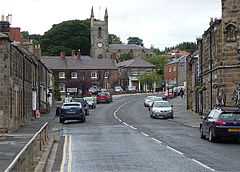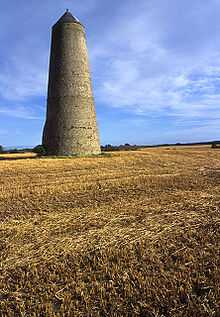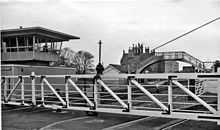Belford, Northumberland
- This article is about the place in Northumberland, England. For other places with the same name see Belford
| Belford | |
 High Street, Belford |
|
 Belford |
|
| Population | 1,055 (2001) |
|---|---|
| OS grid reference | NU108339 |
| Unitary authority | Northumberland |
| Ceremonial county | Northumberland |
| Region | North East |
| Country | England |
| Sovereign state | United Kingdom |
| Post town | BELFORD |
| Postcode district | NE70 |
| Dialling code | 01668 |
| Police | Northumbria |
| Fire | Northumberland |
| Ambulance | North East |
| EU Parliament | North East England |
| UK Parliament | Berwick-upon-Tweed |
|
|
Coordinates: 55°35′53″N 1°49′41″W / 55.598°N 1.828°W
Belford is a village and civil parish in Northumberland, England, about halfway between Alnwick and Berwick-upon-Tweed, a few miles inland from the east coast and just off the Great North Road, the A1. At the 2001 census it had a population of 1,055.[1]
Belford is surrounded by rich pastoral farmland, and to the west of the village is found one of the better rock climbing locations in the county, Bowden Doors.
Governance
Belford is in the parliamentary constituency of Berwick-upon-Tweed and is currently served by Alan Beith (Liberal Democrat). Belford is served by Northumberland County Council.
Economy
The area attracts tourists and there are also a number of businesses based in Belford.
Landmarks
Belford Hall

Belford Hall is a Grade I listed building, an 18th-century mansion house.
The Manor of Belford was acquired by the Dixon family in 1726 and in 1752 Abraham Dixon built a mansion house in a Palladian style to a design by architect James Paine. In 1770 heiress Margaret Dixon married William Brown. Their daughter later married Newcastle upon Tyne merchant, Lt. Col. William Clark, Deputy Lieutenant and High Sheriff of Northumberland who, in 1818, remodelled the house and added two new wings, with the assistance of architect John Dobson.
An extensive park, created in the mid 18th century, retains several original features and has been designated a conservation area. An 18th-century folly in the park is a Grade II listed building. During World War II the Hall was requisitioned by the Army and thereafter became neglected and dilapidated. In the 1980s it was acquired by the Northern Heritage Trust, renovated and restored and converted to residential flats.

Spindlestone Ducket Mill
This is located about 3 km east of Belford, and is an 18th-century tapering cylindrical stone tower with a conical roof of Welsh slate. Its usage is uncertain, being sometimes classified as a windmill and sometimes as a dovecote.[2]
Westhall
Westhall is a privately owned Victorian house built in the style of the castellated fortified house that it replaced on the same site. The moat that surrounded the original building can still clearly be seen. It is now in use as a farmhouse.
History
For much of the Middle Ages, Belford was at the forefront of the ongoing border conflict between the Scots and the English and it is believed that only Well House escaped damage or destruction at the hands of Scottish raiders. In 1272 it is recorded that Walter de Huntercombe, the Lord of the Manor, was charged with 'assisting pirates'! They had seized, by force, goods belonging to some wealthy Spanish merchants and landed with their booty on Holy Island.[3]
In 1726, A wealthy city merchant, Abraham Dixon bought the Belford Estate. He made improvements which enhanced the fortunes of its inhabitants significantly including purchasing a licence in 1742 allowing him to hold a weekly market and two annual fairs at Belford. His son continued improvements after his death in 1746 and by 1770, a visitor was able to report the existence of a woollen mill, a tannery, collieries and a 'large lime kiln'. Improvements to hygiene were also imposed upon the inhabitants with the forced removal of muck heaps from the houses and the banning of swine.[4]
Larger market towns have gradually replaced Belford in importance and the location of the station outside of the town itself did nothing to halt a gradual decline in its fortunes since the end of the 19th century. Many of the features of its heyday have been retained however.
Transport

Belford was for many years a coaching stop on the main A1 road from London to Edinburgh, which passed through the village.[5] However, in 1983 a bypass was opened, and, freed from the constant traffic and pollution, the village could hold events on the High Street and in the Market Place once again.
Belford railway station opened on 29 March 1847. Freight services ceased on 7 June 1965 and the station finally closed for passenger services on 20 January 1968.[6] However, on 8 February 2010 Northumberland County Council agreed plans to resume passenger services by constructing a new platform, access and car parking.[7]
Education
St Mary’s Church of England Voluntary Aided Middle School in Williams Way, Belford[8] provides mainstream education for just under 100 boys and girls aged from nine to thirteen.[9]
Churches
The Church of England parish church of St Mary is an Early English Gothic stone building on a hill overlooking the village. Its tower has two bells.[10] St Mary's was built in about 1200, rebuilt in 1615, and renovated in 1700 and 1828.[11]
Belford has also an United Reformed Church.[12]
Sports
In 2008, Belford Junior Football Club was awarded the Queen's Award for Voluntary Service.[13]
Public services
Belford has an active local history society which has published a series of books in recent years, the latest being 'Bygone Belford' (2010). In 1995 the society carried out A Survey of Belford. A booklet was published and the text of the survey is available online (see external links). A similar survey had been conducted quarter of a century earlier, in 1970.
Notable people
Births:
- Marcus Dods, Scottish divine and biblical scholar, was born in Belford in 1834 [14]
- Robert Mason (Liberal politician) was born in Belford in 1857 and was a member of parliament from 1918 to 1922
- Michael Clark (Canadian politician) was born in Belford in 1861 and moved to Canada in 1902
- Sir William Coldstream, artist, was born in Belford, 28th Feb. 1908 [15]
Residents:
- William Wilson Allen, VC (Rorke's Drift) lived at Belford Moor, (now Belford Mains) as a child.
- Lucy Bronze, an English female footballer who plays for Everton Ladies, lived for a time in Belford
Deaths:
- Geoffrey Hornblower Cock,MC, World War I flying ace died in Belford in 1980
Belford in the media
Belford was featured on the TV programme Countryfile on 10 April 1994, following a telephone call to the BBC by a resident. At the time, like other villages in the area, Belford was suffering from an increasing number of power cuts. Inspired by the programme a group was formed and, after much campaigning and lobbying, the electricity supply was improved.
Belford again achieved momentary fame in April 2000 when protests about the closure of Barclays Bank in the village were picked up and used by the mainstream media to illustrate stories of rural decline brought about by bank branch closures. Until the 1980s there was a branch of Lloyds Bank, with limited opening hours towards the end.
See also
References
- ↑ Census 2001
- ↑ "Spindlestone Ducket, Easington". British Listed Buildings. 22 December 1969. Retrieved 27 January 2011.
- ↑ Local History Society, Belford and District (2010). Bygone Belford. Catrine, Ayrshire: Stenlake Publishing. pp. 3–4. ISBN 9781840335170.
- ↑ Local History Society, Belford and District (2010). Bygone Belford. Catrine, Ayrshire: Stenlake Publishing. pp. 3–5. ISBN 9781840335170.
- ↑ "Belford". Retrieved 27 January 2011.
- ↑ "Belford". Northumbrian Railways. Retrieved 27 January 2011.
- ↑ "County council go-ahead for Belford station plan". the Berwick Advertiser. 10 February 2010. Retrieved 27 January 2011.
- ↑ Shan Scott (12 July 2006). "The Belford St Mary’s Church of England Voluntary Aided Middle School (Designation as having a Religious Character) Order 2006" (PDF). Department for Education and Skills Statutory Instrument. Retrieved 1 February 2011.
- ↑ "St Mary's Church of England Middle School". The Good Schools Guide. 2011. Retrieved 1 February 2011.
- ↑ "Kelly's Directory of Northumberland and Durham". 1873. p. 495. Retrieved 1 February 2011.
- ↑ "Parish Church of St. Mary, Belford, Northumberland". Northumberland Cam. Retrieved 1 February 2011.
- ↑ "United Reformed Church Belford". Belford Village. 2011. Retrieved 1 February 2011.
- ↑ "2008 Winners, North East". The Queen's Award for Voluntary Service. The Cabinet Office. Retrieved 2008-06-08.
- ↑ Gary Screaton Page (2009). "More Like The Master" (PDF). Retrieved 1 February 2011.
- ↑ "Sir William Coldstream". Retrieved 4 November 2011.
External links
| Wikimedia Commons has media related to Belford, Northumberland. |
- Images of Belford Castle site with history notes
- Village 'devastated' at losing bank - news from the BBC in April 2000
- Bowden Doors described, at UKClimbing.com
- GENUKI (Accessed: 1 November 2008)
- Northumberland Communities (Accessed: 1 November 2008)
- North Northumberland Online - a page about Belford and the online version of A Survey of Belford 1995
- Berwick Advertiser - an article about 'Bygone Belford' - a book by Belford's local history society